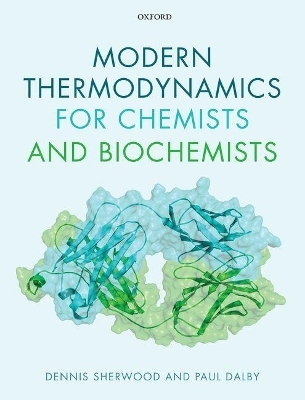
Modern Thermodynamics for Chemists and Biochemists
Oxford University Press (Verlag)
978-0-19-878295-7 (ISBN)
Thermodynamics is fundamental to university and college curricula in chemistry, physics, engineering and many life sciences around the world. It is also notoriously difficult for students to understand, learn and apply. What makes this book different, and special, is the clarity of the text. The writing style is fluid, natural and lucid, and everything is explained in a logical and transparent manner. Thermodynamics is a deep, and important, branch of science, and this book does not make it "easy". But it does make it intelligible.
This book introduces a new, 'Fourth Law' of Thermodynamics' based on the notion of Gibbs free energy, which underpins almost every application of thermodynamics and which the authors claim is worthy of recognition as a 'law'. The last four chapters bring thermodynamics into the twenty-first century, dealing with bioenergetics (how living systems capture and use free energy), macromolecule assembly (how proteins fold), and macromolecular aggregation (how, for example, virus capsids assemble). This is of great current relevance to students of biochemistry, biochemical engineering and pharmacy, and is covered in very few other texts on thermodynamics. The book also contains many novel and effective examples, such as the explanation of why friction is irreversible, the proof of the depression of the freezing point, and the explanation of the biochemical standard state.
Dennis Sherwood is Managing Director of The Silver Bullet Machine Manufacturing Company Ltd. Dennis coauthored Crystals, X-rays and Proteins (Oxford University Press, 2010) and is the author of Introductory Chemical Thermodynamics (Longman, 1971). He earned his PhD in Biology at University of California at San Diego. Paul Dalby is Professor of Biochemical Engineering and Biotechnology at University College London, and Co-Director of the EPSRC Centre for Innovative Manufacturing in Emergent Macromolecular Therapies. Paul's research combines protein engineering and formulation, with biophysical characterisation, to understand the factors that influence protein stability. This informs protein engineering and formulation designs that can improve therapeutic protein manufacturing and delivery to patients. Paul earned his PhD in Chemistry from the University of Cambridge.
Part 1 - Fundamentals
1: Systems and states
2: Work and energy
3: Temperature and heat
4: Thermodynamics and mathematics
Part 2 - The Three Laws
5: The First Law of Thermodynamics
6: Enthalpy and thermochemistry
7: Ideal gas processes - and some non-ideal ones too
8: Spontaneous changes
9: The Second Law of Thermodynamics
10: Clausius, Kelvin, Planck, Carathéodory and Carnot
11: Order, information and time
12: The Third Law of Thermodynamics
Part 3 - Free energy, spontaneity and equilibrium
13: Free energy
14: Chemical equilibrium and chemical kinetics
Part 4 - Chemical applications
15: Phase equilibria
16: Reactions in solution
17: Acids, bases, and buffer solutions
18: Boiling points and melting points
19: Mixing and osmosis
20: Electrochemistry
21: Mathematical round-up
22: From ideal to real
Part 5 - Biochemical applications
23: The biochemical standard state
24: The bioenergetics of living cells
25: Macromolecular conformations and interactions
26: Thermodynamics today - and tomorrow
| Erscheinungsdatum | 29.09.2018 |
|---|---|
| Zusatzinfo | 93 BW line figures |
| Verlagsort | Oxford |
| Sprache | englisch |
| Maße | 194 x 249 mm |
| Gewicht | 2048 g |
| Themenwelt | Naturwissenschaften ► Biologie ► Biochemie |
| Naturwissenschaften ► Chemie ► Physikalische Chemie | |
| Naturwissenschaften ► Physik / Astronomie ► Thermodynamik | |
| ISBN-10 | 0-19-878295-0 / 0198782950 |
| ISBN-13 | 978-0-19-878295-7 / 9780198782957 |
| Zustand | Neuware |
| Haben Sie eine Frage zum Produkt? |
aus dem Bereich


